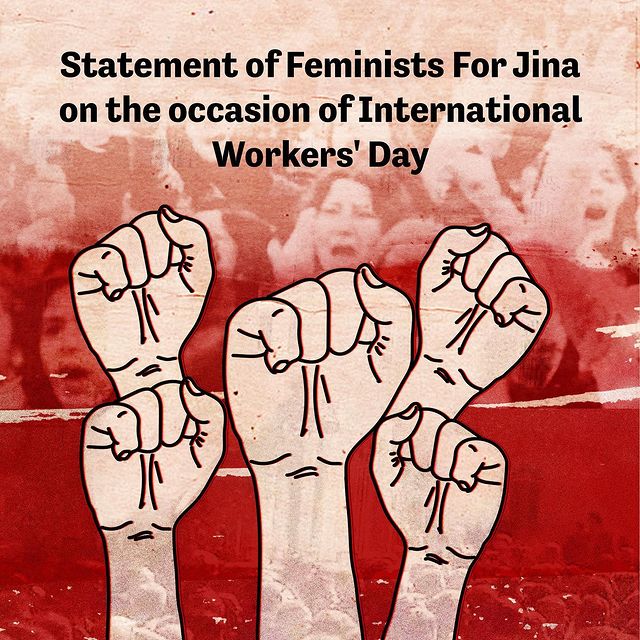On this 1st of May 2023, International Workers’ Day, nearly eight months after the murder of Jina (Mahsa) Amini by the Iranian state, we are led by the belief in the possibility of building “a new world of equality” 1 and the revolutionary uprising of those in the margins against the center which continues and the uproars and sounds of this revolutionary uprising which can be heard “from houses to factories, from schools to streets”2.
Along with the continuous resistance of women and trans people, who are aware of their right to their bodies, towards establishing “the right to choose what we wear”, and along the struggle of families against chemical attacks on girls’ schools, this year we are witnessing one of the most extensive workers’ strikes all around Iran.
Nationwide strikes of nurses, medical staff and workers, especially in the oil and gas and petrochemical sectors, are ongoing in many cities and in more than a hundred contracting companies. Just wages and salaries, payment of back wages, ensuring work safety and job security are among their most basic demands. Nevertheless, on the eve of International Labor Day, as a first response to labor strikes, more than four thousand workers of South Pars [project] were fired and fifteen labor activists were arrested. This is apart from the silent and everyday murders of Koulbar(s) and Soukhtbar(s) (cross border laborers employed to carry goods and petrol in western and southern parts of the country), whose lives, works and deaths are a clear evidence of class, ethnic and gender exploitation in the marginalized parts of Iran. Moreover, the daily suffering of Afghan immigrants as cheap labor in buildings, workshops and houses who are victims of both exploitation and racism should be underlined and emphasized.
Apart from the organization of strikes and connecting the waves of strike, what is most visible is the intertwining of class-based voices and demands with feminist demands. This multi-faceted and multi-voicedness has been correctly echoed in various statements, charters and slogans that have been published so far. Now, “Woman, Life, Freedom” has become the slogan of a revolution where the issues of women and gender have become visible in all social layers and classes, and the strength of this revolution lies in staying in this continuum.
Gender oppression is not separate from class oppression; it lies at the basis of the spread of poverty. The ideological and capitalist structure of the authoritarian Islamic regime of Iran is based on defining a duality of man/woman and the assignment of reproductive work (caring labor) to women, while devaluing it, and productive work with economic value to men.
The patriarchal regime’s policies amount to ever more increasing impoverishment and poverty. These policies include unbridled privatizations, keeping an oil-based economy, the plundering of natural resources, and rampant financial corruption at all levels of the government, especially the IRGC, the absence of any law and support structure for workers, as well as the arrest and suppression of union and labor activists. The expansion of job instability in order to remove the pension and insurance funds that play an important role in creating the so-called low-wage female jobs is also one of the outcomes of these policies. The prevailing gender apartheid and sexual and gender violence, especially in the workplace and the imposition of compulsory hijab, have made both public and work spaces limited and unsafe for women and trans people. Moreover, in some areas they have been completely excluded from paid and waged work. The heartbreaking death of Marzieh Taherian, a textile factory worker whose veil got stuck in a machine and dragged her head into the machine, has not been forgotten.
According to one of the reports of the Iranian Statistics Center, the rate of economic participation of women by the end of summer 2022 was about 13.7%, which shows a decrease of 4% after the Corona crisis. During the Covid pandemic in Iran, 75% of the workers who lost their jobs were women. All these show that women are systematically excluded from the job market and a woman who has no way to the market, can never negotiate her income or make demands for her right to just wages. As a consequence, unemployment and informal jobs such as vending goods in streets or working at people’s homes and all kinds of criminalized work are imposed on women and trans people, all of which leads to the feminization of poverty.
Population growth policies that limit and prohibit access to contraceptives and abortion, along with the high costs of child care centers and limited school hours on the one hand, and the lack of government senior caring centers and facilities on the other, limit women’s employment and turn them into unpaid nurses. Privatization of the medical and the education sectors hinders many people from access to these services. Meanwhile, women suffer the most because wherever access to care and medical services are blocked, the burden of compensation falls on women.
Acknowledging and recognizing that gender oppression and class oppression are intertwined means continuing on the road of “woman, life, freedom”. Gender equality and the right to the body, of which the freedom of clothing is a small part, is tied to the issue of wages and the presence of women in the labor market. Therefore, the effective and practical solidarity of their comrades – mostly men – with working women and queer people is of great importance. Liberation from any type of oppression is not possible except through organization and structural transformation, because all types of oppression are linked together like a chain. We will not stop fighting until there is a fundamental revolution in the political, social, and economic structures of the society, because “we have nothing to lose but our chains”3 and because resistance is life.
———-
- Cited phrase from a revolutionary song of Iranian women.
- Cited phrase from revolutionary slogans
- Cited with some modification from The Communist Manifesto’s last sentence.

